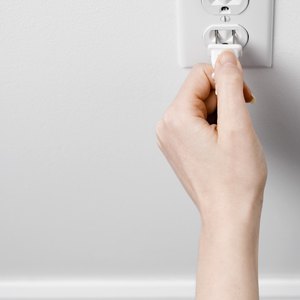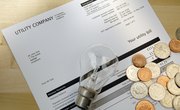
High electric bills can make you struggle with your budget. A bill that fluctuates from month to month can be unpredictable. However, you can get a handle on your electricity consumption and make electric bills go down every month through steady change and making improvements to your home. While not everything in your home uses the same amount of energy (see Resources), cutting back on how you use appliances and areas in your home can create a drop in your bill.
Immediate Changes
Control the temperature in your home to keep your heated winter temperature to about 68 degrees Fahrenheit and your summer cooling temperature to about 78 degrees. Use a bedroom ceiling fan, rather than leaving air conditioning running overnight, in summer.
Turn off lights in rooms you aren’t using and switch your light bulbs to CFLs (compact fluorescent lights) to save energy when the lights are on. Insert inexpensive solar lights into the ground outside your front and back doors rather than turning on a porch light.
Decrease the maximum temperature of your hot water heater to 120 degrees. Take short showers, rather than baths, to save on the amount of water used and therefore heated for bathing.
Wash clothes with cold water and only run your washing machine and dishwasher when fully loaded unless you can select half-sized loads.
Turn off and unplug unnecessary appliances when not in use such as TVs, coffee makers, computers, game systems and microwaves. Even when not in use, these appliances can suck power from your home by lighting “off” lights, displaying the time and lighting up just to show that they are plugged in.
Hang thick curtains or use blinds along your southern facing windows. Keep the curtains open during the winter to allow the sun to help warm your home. Close the curtains or blinds in summer to block the hot rays and help maintain cool temperatures indoors.
Long-Term Changes
Replace your appliances with Energy Star appliances, which use less electricity. This includes water-saving washing machines, dishwashers with “air dry” options and dryers which sense when clothes are dry rather than continuously running for a set period of time.
Install a thermostat which is programmable to make temperature control consistent. Program the thermostat to allow the house to be more cool or warm, depending on season, during hours when you aren’t home or are asleep.
Install solar panels around your house to produce your own electricity. Even if the panels cannot support the entire electrical needs of your home, they can alleviate the size of your monthly bill.
Maintain your home’s filter system. Change filters regularly and keep any vents free of obstructions so air flow is not prevented from its natural patterns through your home.
Fix any drafts and air leaks around doors and windows as needed to maintain a cool summer home and keep heat in during the winter. Replace any windows which are old and cannot be fixed to prevent leaks.
Inspect the insulation around your home for areas in your attic or basement which may need to be replaced or could be improved.
Tips
Frequently there are tax advantages to updating your home with more energy-efficient items from appliances to windows and doors. Consult your tax preparer to see which items offer a tax credit this year. Make lifestyle changes for using your appliances, such as washing clothes or dishes in the mornings before your air conditioner is fighting to cool the house. Also, consider grilling out more during the summer to avoid baking in the oven.
References
Tips
- Frequently there are tax advantages to updating your home with more energy-efficient items from appliances to windows and doors. Consult your tax preparer to see which items offer a tax credit this year.
- Make lifestyle changes for using your appliances, such as washing clothes or dishes in the mornings before your air conditioner is fighting to cool the house. Also, consider grilling out more during the summer to avoid baking in the oven.

